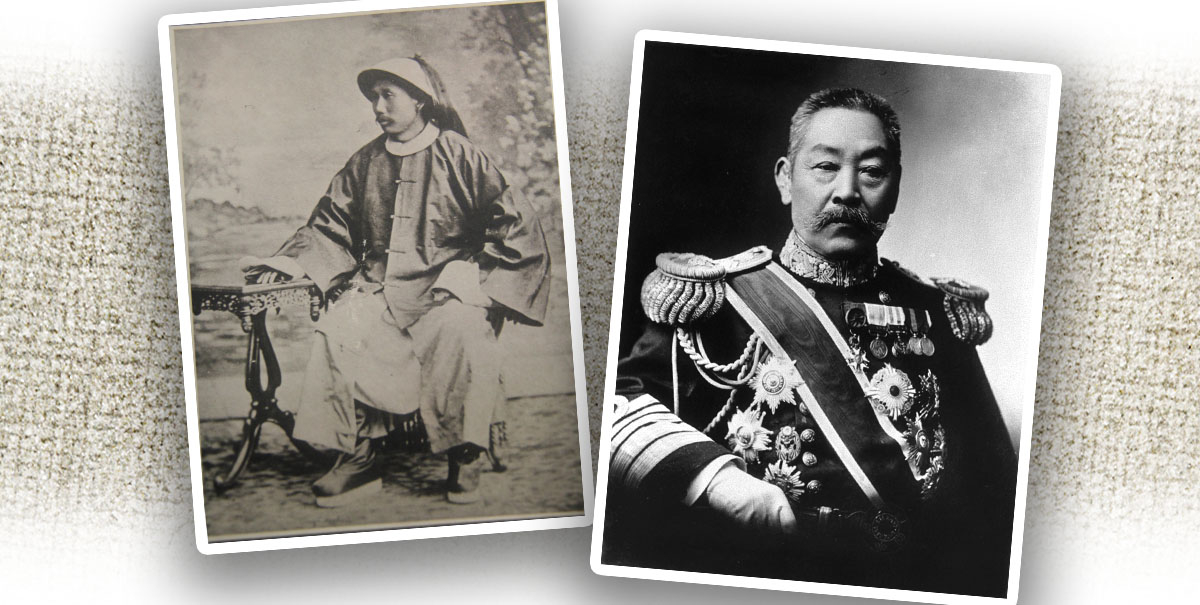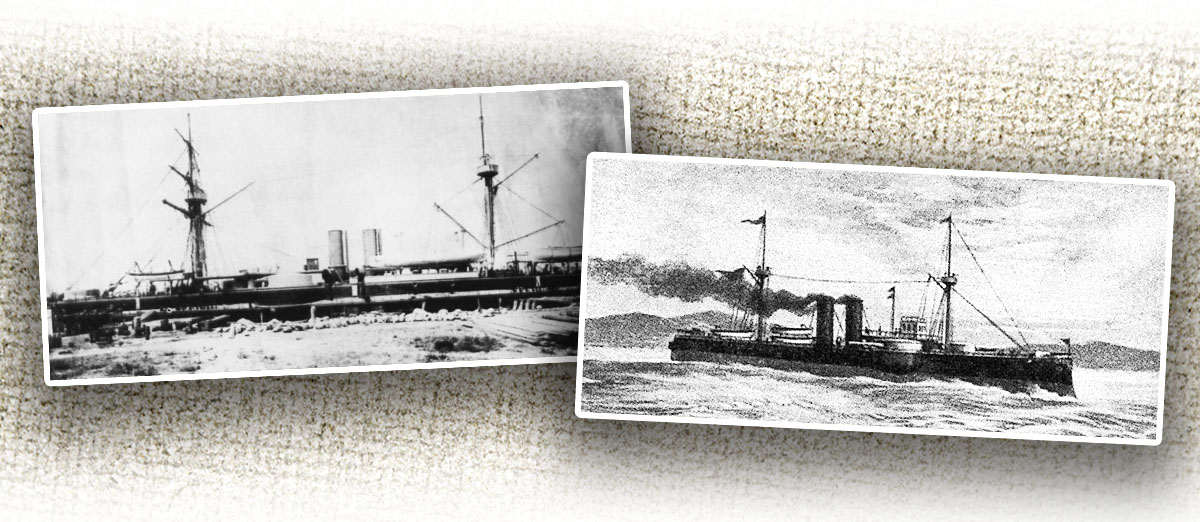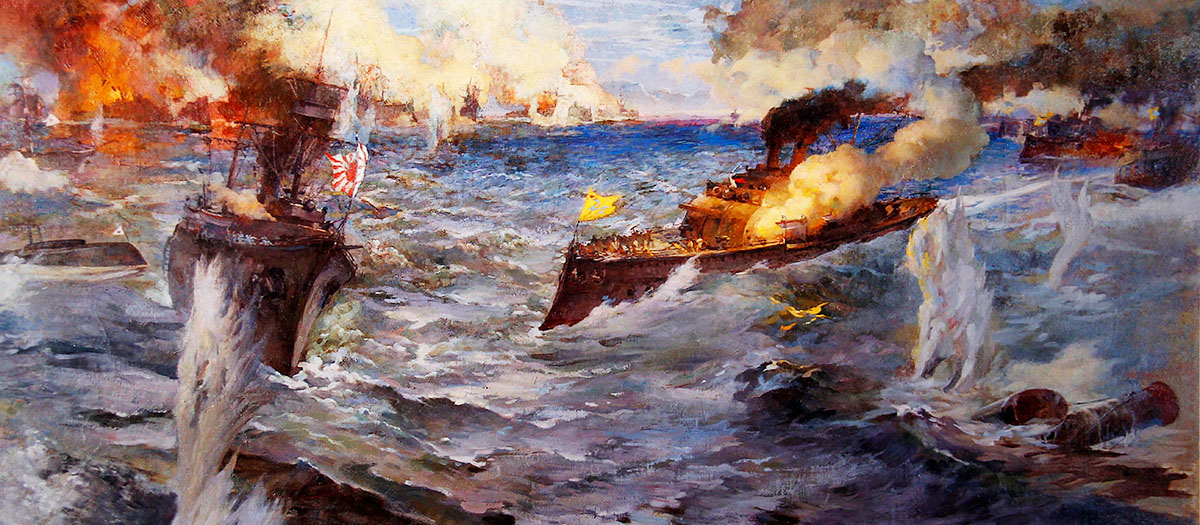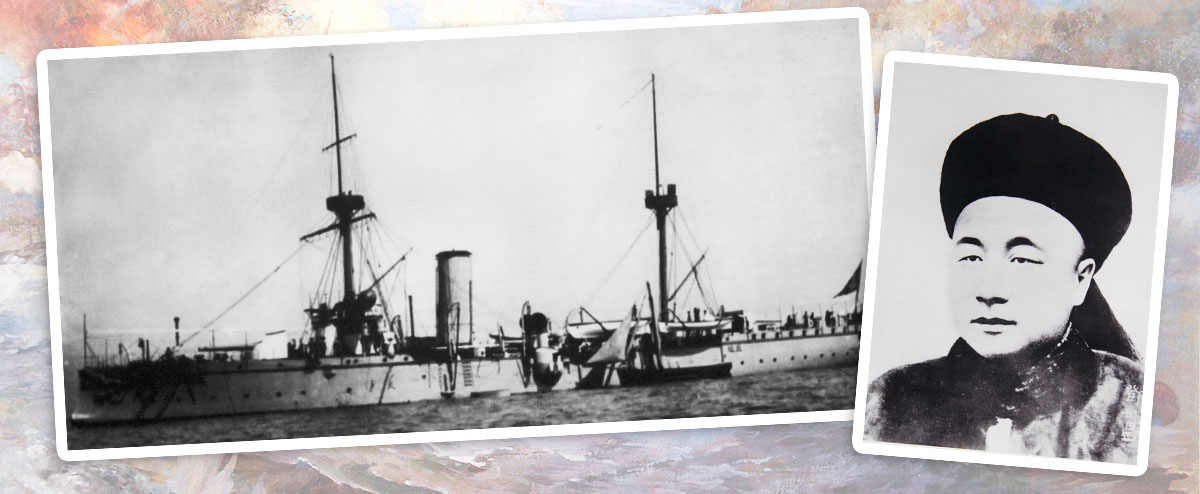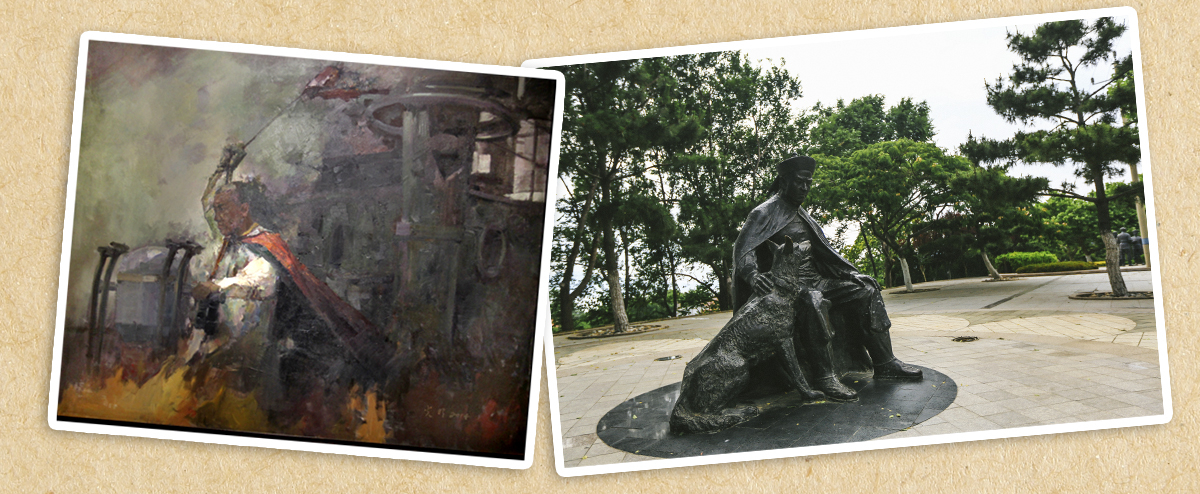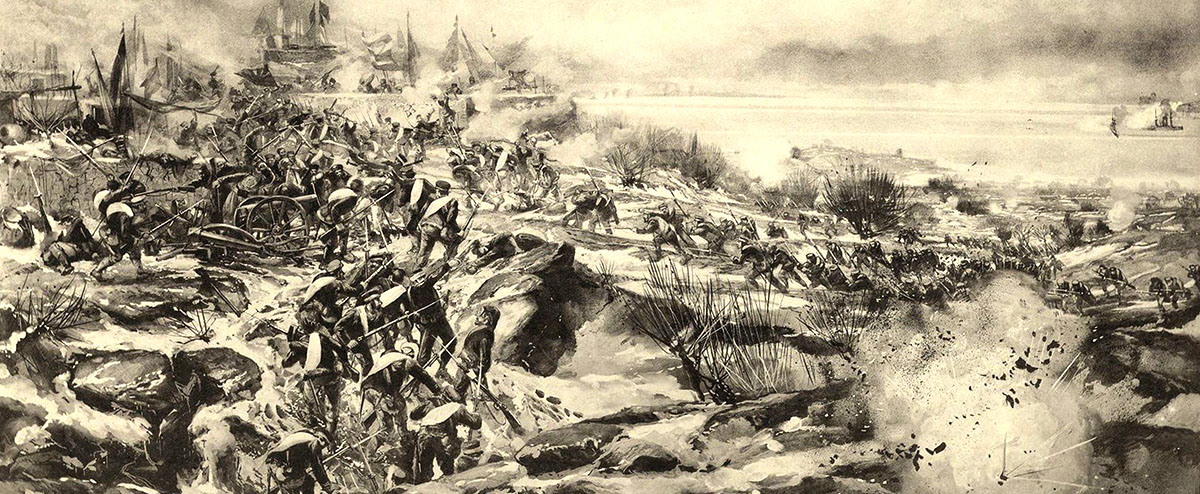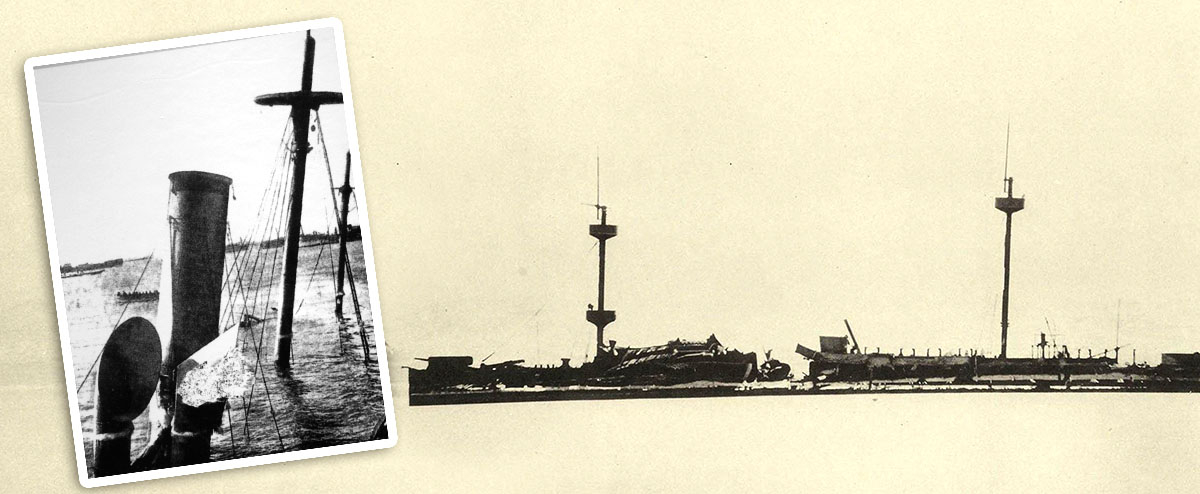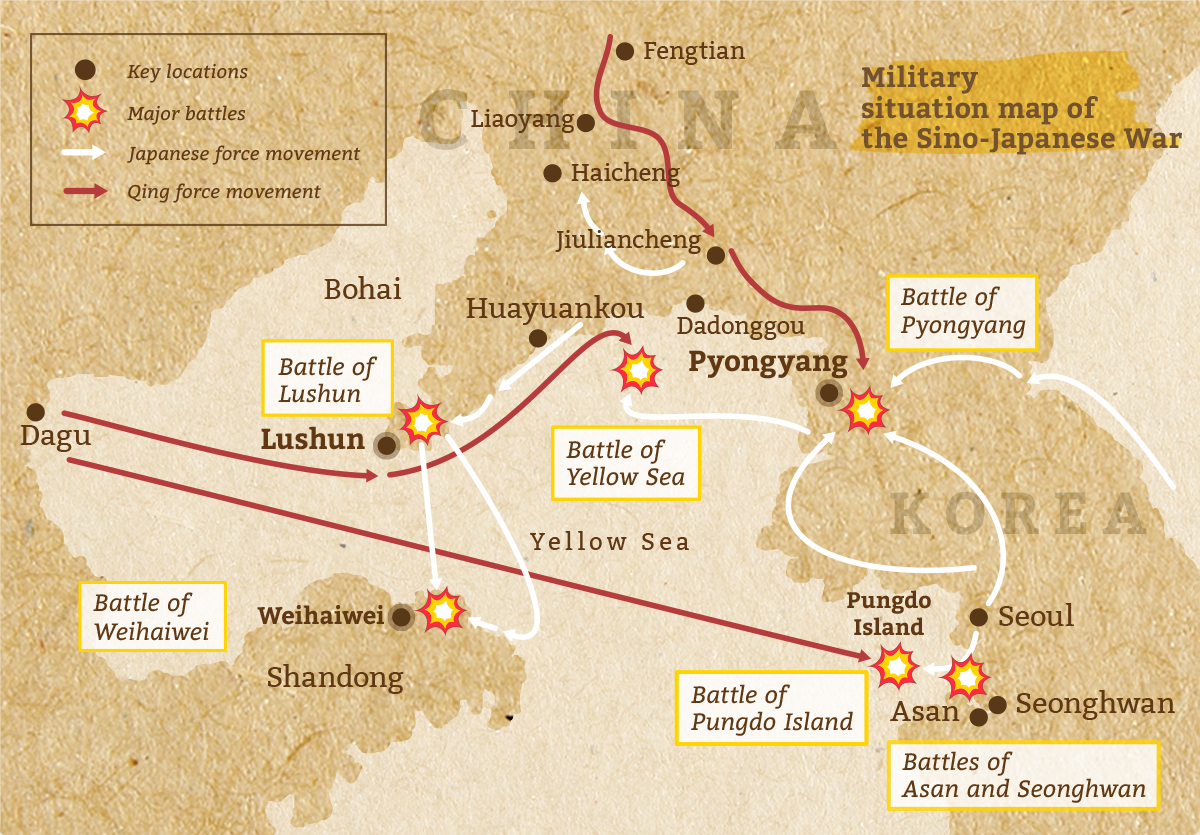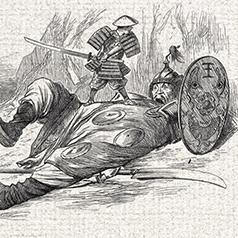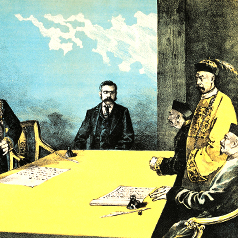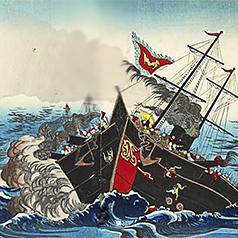The Battles of the Yellow Sea (1894) and Weihaiwei (1895) were decisive naval battles in the First Sino-Japanese War. The Beiyang Fleet of China – formed during the Self-Strengthening Movement under Governor-General Li Hongzhan (李鴻章) – engaged the Japanese navy in the Yellow Sea in September 1894. The overall capability of the Japanese fleet was far above that of China in terms of tonnage, firepower, speed and strength. The Beiyang Fleet also suffered from insufficient training and maintenance – its flagship Dingyuan had not been maintained or refitted for 7 years despite having been in service for 12 years.
During the battle, Dingyuan was heavily damaged while Commander-in-Chief Admiral Ding Ruchang (丁汝昌) was critically injured. Chinese cruiser Zhiyuan under the command of Captain Deng Shichang (鄧世昌) charged on Japanese cruiser Yoshino, but was sunk by a torpedo. In total, five Chinese warships sank while four Japanese warships, including the flagship Matsushima, suffered considerable damage.
The Beiyang Fleet, despite being battle-worthy, withdrew to the port of Weihaiwei (威海衛) and refrained from engaging the enemy, following the strict orders of Li Hongzhang. In early 1895 when Weihaiwei came under heavy Japanese land and naval attacks, over 20 Chinese warships sat in the bay making no attempt to attack the Japanese or to defend themselves. What remained of the fleet surrendered as Admiral Ding Ruchang committed suicide by poison, destroying 30 years of China’s modernization efforts.
|
|
What were the reasons for Beiyang Fleet’s repeated losses during the naval battles? |
|
|
See answer below. |
While the land forces of the two countries were engaged in battle, their naval forces also prepared for a decisive sea battle. Pictured are the naval commanders of the First Sino-Japanese War, Ding Ruchang, Commander-in-Chief of the Beiyang Fleet, and Itō Sukeyuki, Commander-in-Chief of the Combined Fleet (right).
Ding Ruchang rose from the ranks of the Huai Army and his past experience mainly involved suppressing civil unrest with cold weapons, and thus was looked down upon by some naval captains who had studied advanced naval warfare overseas. Itō Sukeyuki had served in Japan’s modernized navy since the start of the Meiji Restoration as captain on numerous modernized warships, and was an experienced and highly respected commander within the navy.
Pictures of the Beiyang battleships Dingyuan (left) and Zhenyuan (right). Dingyuan and Zhenyuan, deployed in the Sino-Japanese naval battle, were the Beiyang Fleet’s largest and most heavily armored capital ships. With a displacement of over 7,000 tons each and equipped with large cannons, they outclassed the Japanese vessels at that time. Dingyuan, the flagship, was to command the fleet in the battle.
Pictures of the Japanese cruisers Matsushima (left) and Yoshino (right). Both were famous for their feats in the First Sino-Japanese War.
The Matsushima was Japan’s flagship during the Battle of the Yellow Sea, and the Yoshino was a newly commissioned warship. The Yoshino was completed on September 30, 1893, less than one year before the Sino-Japanese naval battle, and was one of the fastest and most technologically advanced warships in the world at that time. It had participated in the Battle of Pungdo Island that sunk the Qing’s troop transport vessel Kowshing on July 25, 1894. In comparison with the Qing fleet, the Japanese fleet had the advantage of being newer, more advanced, faster, equipped with greater firing range, and was overall the superior fleet. However, while the Japanese fleet did have an edge, it was not an overwhelmingly large one. Even the Japanese themselves were not certain whether victory was possible, and had set up different scenarios prior to the war to plan for subsequent actions - victory, defeat or stalemate. The Chinese fleet’s weaknesses were a lack of new vessels, poorly maintained older vessels and overall tactical errors, which ultimately cost them the battle.
The cruiser Naniwa had sunk the Qing’s troop transport vessel Kowshing during the Battle of Pungdo Island, and went on to participate in the battles of the Yellow Sea, Lushun, Weihaiwei and Taiwan (台灣). It was captained by Tōgō Heihachirō.
Tōgō Heihachirō, admiral of the Japanese Combined Fleet during the Russo-Japanese War of 1904 to 1905, won a number of victories against the Russian naval forces. During the Battle of Tsushima in 1905, The Combined Fleet that Tōgō Heihachirō commanded virtually annihilated the Second Pacific Squadron of the Russian Baltic Fleet, winning a decisive victory for Japan and worldwide acclaim for himself as one of the greatest commanders in modern naval history.
An oil painting depicting the Sino-Japanese naval battle of the Yellow Sea. This decisive battle took place on September 17, 1895 between the elite naval forces of China and Japan. It was considered the most symbolic event of the First Sino-Japanese War and it ended with China’s utter defeat.
During the Battle of the Yellow Sea, over 10 warships were deployed on each side and they exchanged intense fire for over five hours. Of China’s Beiyang Fleet, the five warships Zhiyuan, Jingyuan, Chaoyong, Yangwei and Guangjia were sunk while Laiyuan sustained heavy damage. Over 600 officers were killed or injured in action. The four warships of the Japanese Combined Fleet - Matsushima (flagship), Hiei, Akagi and Saikyō Mara - were heavily damaged, with more than 300 men dead or injured, including Sakamoto Hachirōta, the captain of Akagi, who was killed. Though the Beiyang Fleet sustained heavy losses, its capital ships were still battleworthy and could have fought on. Nevertheless, the remaining fleet retreated to a military port on Li Hongzhang’s orders to “avoid fighting and save the ships” and did not re-enter battle, in effect handing marine control to the Japanese.
The warship Zhiyuan and her captain Deng Shichang (鄧世昌). Most of the Beiyang Fleet fought valiantly in the Battle of the Yellow Sea. The actions of the warship Zhiyuan were particularly heroic.
On the left: Oil painting of Deng Shichang, hero of the First Sino-Japanese War; on the right: statue of Deng Shichang and his faithful dog at modern-day Liugong Island (劉公島) of Weihai City (威海市), Shandong (山東). Deng Shichang ordered his blazing vessel Zhiyuan to close on the enemy warship and attempt to ram it, and ultimately perished along with over 200 men on board.
During the fierce naval battle of the Yellow Sea, when the flagship Dingyuan was struck by cannon fire and set ablaze, Deng Shichang ordered the crew of his vessel, Zhiyuan, to distract enemy ships by trying to ram one of them. This took the pressure off the Dingyuan, thus protecting the flagship from imminent danger. Later, heavily damaged by enemy fire and out of ammunition, Deng Shichang ordered his doomed vessel to hit the enemy warship Yoshino at full speed, determined to ram and sink it in a suicide attack. However, the Zhiyuan was sunk by a torpedo before it could close on the Japanese warship. Deng Shichang and over 200 officers on the ship died. Emperor Guangxu, moved to tears by Deng Shichang’s heroic act, wrote, “On this day, the people shed tears but your act of courage has raised the navy's morale.”
Besides the crew, Deng Shichang’s faithful dog also perished along with him when the Zhiyuan sunk. As the doomed vessel went down, Deng Shichang could have been rescued, but he chose to perish with his ship, declaring “I live to serve my country and destroy its enemies, and it is only proper for me to die at sea now. Why should I try to survive?”
His faithful dog, Sun, swam to his side and gripped its master’s arm in its mouth, and refused to let go. In the end, both man and dog were swallowed by the waves. Today, there are many statues of Deng Shichang in Weihai City, and in some of them his faithful dog is by his side.
On January 20, 1895, the Japanese waged war on Weihaiwei and overpowered its Qing defenders.
What remained of the Beiyang Fleet was anchored in its home base, the port of Weihaiwei after the disastrous Battle of the Yellow Sea. The Japanese, now with marine control, went on to attack Liaodong (遼東), Shandong (山東) and nearby regions. Once Lushun (旅順) was captured, the Japanese army decided to target Weihaiwei, and mounted a concerted sea-land attack on Weihaiwei on January 20. In the battles that followed, the Japanese had every advantage and captured numerous cannon batteries.
The Chinese warships Weiyuan and Dingyuan were torpedoed and ultimately sunk during the Battle of Weihaiwei. The annihilation of the Beiyang Fleet during the Battle of Weihaiwei sealed Japan’s victory in the First Sino-Japanese War.
On February 3, 1895, as Weihaiwei fell under Japanese control, Liugong Island (where the Beiyang Naval Command Headquarters was located) was completely cut off. On February 6, the Chinese warship Weiyuan was sunk by a Japanese torpedo; on February 10, 1895, the warship Dingyuan was split in half by a Japanese torpedo and lost its combat capability. Captain Liu Buchan (劉步蟾) ordered the ship scuttled before committing suicide himself. The next day, the Beiyang Fleet’s Commander-in-Chief Ding Ruchang also took his own life. On February 17, the Japanese captured Liugong Island, completing their victory. The Beiyang Fleet was annihilated as the remaining warships in the naval base were either sunk or captured. The Qing court had no choice but to swallow their pride and seek peace.
Military situation map of the First Sino-Japanese War
After the First Sino-Japanese War, Li Hongzhang is reported to have lamented: "All the things I've done in my life - be it training an army or founding a navy - are mere paper tigers as I've never been given the freedom to do a proper job. I could only try my best to adorn them so that they look fine on the outside. As long as the veneer is intact, they may yet pass for the real thing for a while. Just as a plasterer can patch a broken house here and there so that it looks as if it is in good shape, all people can discern is the paper veneer, but not the materials underneath. Of course, a little rain or wind will dent it here and there, but with speedy repairs, it should hold up just well enough. However, if you must rip away the veneer without any repair materials on hand or knowledge of how to rebuild the house, the truth will be laid bare and the situation will become unsalvageable. How can the plasterer, with his limited skills, be held accountable for the mess?”
|
|
What were the reasons for Beiyang Fleet’s repeated losses during the naval battles? |
|
|
Before the war, both Chinese and Japanese naval forces modernized based on Western technology and expertise. However, China did not insist on continued military training and learning or maintenance of military equipment. For instance, Beiyang’s flagship Dingyuan had not been maintained for 7 years despite having served for 12 years. A portion of the military expenditure was allegedly spent on building the Summer Palace. Hence, China lagged behind Japan considerably in terms of fleet tonnage, firepower, speed and strength (China had 195 guns while Japan had 268). During the Battle of the Yellow Sea, despite a number of strategic and tactical mistakes, Chinese naval forces remained somewhat battle-worthy, partly because Japanese warships had also suffered considerable damage. What cost China dearly was a defeatist attitude as some twenty Chinese warships sat almost idle unwilling to engage the invading forces at the port of Weihaiwei. |
Source of most photos used in this feature piece: Fotoe (pictures 1-9), Visual China Group (picture 7), misc. photo sources.





